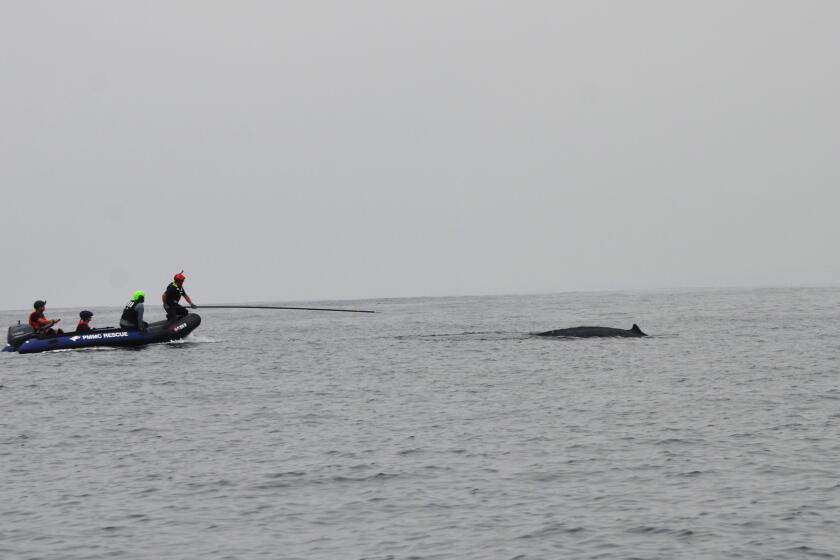In Wake of Raid, Shelter Defends its Care : Animals: State officials allege ‘wildlife abuses’ at the San Gabriel Valley Humane Society. Center’s employees deny any wrongdoing.
Workers and administrators at the San Gabriel Valley Humane Society and Wildlife Rehabilitation Center are still stunned by the raid there last month.
“It wasn’t a drug raid, but it sure seemed like one,” veterinarian Don Needham said.
On Jan. 26, armed state Department of Fish and Game wardens seized 21 animals and birds from the shelter, alleging “wildlife abuses.” They assembled the shelter’s animal handlers in a separate room, then proceeded to carry off, among others, an Arctic fox, a coyote, four raccoons, a deer, four hawks and seven desert tortoises. Most of the animals had been there for five years or more.
They did not remove any of the shelter’s 275 domestic animals.
The raid didn’t make sense, said Joan Coleman, director of the Humane Society, which serves eight San Gabriel Valley cities. The state agency has known for years about the wild animals housed there, she said.
“All they ever said was that this was one of the nicest places they’d seen,” she said.
But Fish and Game authorities, who are preparing misdemeanor charges against Coleman and her son, Assistant Director John Coleman, stick by their guns.
They say that wild animals were being held in cages that were smaller than the legal size limits; that the shelter was holding wild animals without a permit, and that there was no licensed rehabilitator working to prepare wild animals for eventual release.
Fish and Game spokesman Curt Taucher said state wardens made a videotape of the shelter as evidence. “It’s pretty graphic,” he said. “It shows hawks in parrot cages. There’s a hawk with a five-foot wingspan in a cage that’s at most two or three feet wide. It shows layers of feces in the raccoon cage.”
The Colemans would face up to a year in jail and $1,000 in fines for each of five misdemeanor charges. The shelter itself is being denied formal recognition as a wildlife rehabilitation center, where injured wild animals can be treated.
Coleman said that although she had allowed her state permits to lapse in 1988, state officials had never intimated that her program was in jeopardy.
She added that the shelter had released many injured wild animals after they were treated and that Needham is a respected wildlife rehabilitator. But the animals seized by state agents were mostly “unreleasable,” too disabled or too tame to survive in the wild, she said. These included a one-eyed owl, a blind raccoon and a hawk with a damaged wing.
She said the state wardens arrived just as staff members were cleaning up. Hawks had been housed overnight in parrot cages to protect them from cold night air, she said. Their normal cage, an 8-by-10 cubicle, is outdoors, she said.
Coleman said the Fish and Game charges were “fraught with lies and secondhand hearsay.” She would not elaborate.
For the past 33 years, the Humane Society, which serves San Gabriel, Temple City, Monrovia, Azusa, Monterey Park, Glendora, West Covina and Covina, has been largely the handiwork of Joan Coleman, according to animal activists from the area.
In the loosely knit world of animal protection and animal activism, Coleman has developed a reputation among some as a strict administrator who is adept at squeezing profits out of a litter of kittens or a stray dog. One local veterinarian called her “ironhanded.”
The Society’s annual budget has averaged about $700,000 in recent years, almost 90% of it from the sale and servicing of pets. The rest is made up by contributions and grants.
There are 20 employees; according to tax forms obtained by The Times, only Coleman and her son earn more than $30,000 a year. In 1989, Joan Coleman earned $60,150, and her son got $47,689.
South Pasadena animal activist Maida Henderson, who represents various animal rescue groups, said smaller dogs at the shelter are sometimes housed with larger, more aggressive dogs, who leave them seriously injured.
Steve McNall, director of the Pasadena Humane Society, would not talk directly about his counterpart. But he said he disagreed with the notion of using disabled or tame animals for display. “I don’t believe that, for example, an eagle with one eye or one wing should be used as a decorative item, sitting in a cage for the rest of his life,” McNall said.
He said that the Pasadena facility generally destroyed wild animals that could not be rehabilitated.
Jo Isenberg, a past president of Protectors of Animals, the principal volunteer group associated with the shelter, said the shelter has consistently refused to give animals to medical researchers and has made special efforts to find homes for older dogs and cats.
She defended the practice of keeping disabled wild animals alive. “Ask the hawk who’s had his wing shot off if he’d rather be alive or dead,” she said.
More to Read
Sign up for Essential California
The most important California stories and recommendations in your inbox every morning.
You may occasionally receive promotional content from the Los Angeles Times.






